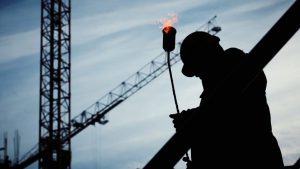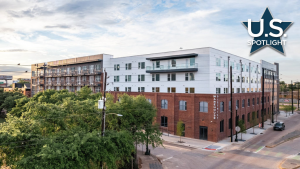This past summer, several U.S. cities made headlines due to heat waves magnified by their vast paved areas, tall buildings and lack of greenery and trees. As global temperatures increase, more urban centres around the world will become “heat islands.”
Houston serves as a useful example. The city was been ranked the fourth worst heat island in the United States by non-profit news organization Climate Central, behind New Orleans, Newark and New York. Specifically, it is reported that Houston is 15 F to 20 F hotter than its surrounding rural area.
Scientific American writes heat is the deadliest form of severe weather.
“When severe heat hits places where most people are unaccustomed to it…it can be especially deadly. Elderly people, children and those with already existing conditions such as heart, respiratory or kidney disease are particularly vulnerable.”
If it hasn’t happened yet, extreme heat is coming to a Canadian city near you. Planners, designers and engineers need to address urban heat islands. Several solutions exist.
For example, planting trees really helps. Trees provide shade of course, and also encourage biodiversity. Green roofs atop buildings, when designed correctly, can reduce heat radiating to the interior. Together, trees and green roofs help lower the heat island thermostat, thereby lowering electrical demands for air conditioning while making the urban outdoors more comfortable. Simultaneously, they can reduce air pollution, provide oxygen and capture carbon emissions.
But time is a factor. In cities like Houston, where less than 20 per cent is shaded at all, millions of trees need to be planted to make a measurable difference. Trees take years to grow sufficiently to provide meaningful shade. Green roofs can’t be built overnight. Cities need solutions now.
That’s why heat-absorbing paved surfaces that can make up to 40 per cent of a city’s area need to perform better.
Hessam AzariJafari and Randolph Kirchain, two researchers at the Concrete Sustainability Hub of the Massachusetts Institute of Technology (MIT CS Hub), write that, “building lighter-coloured, more reflective roads has the potential to lower air temperatures by more than 2.5 degrees Fahrenheit (1.4 C) and in the process, reduce the frequency of heat waves by 41 per cent across U.S. cities.”
AzariJafari and Kirchain have been experimenting with light-reflecting materials that can be incorporated into pavement. Using a measure called “albedo” to quantify the amount of reflective material used, the MIT CS Hub reports, “an increase in pavement albedo on all U.S. roads could lower energy use for cooling and reduce greenhouse gas emissions equivalent to four million cars driven for one year. And when materials are locally sourced, such as light-coloured binders or aggregates, crushed stone, gravel or other hard materials in concrete, these roads can also save money.”
At the same time, AzariJafari and Kirchain caution that the placement of reflective paved surfaces must be strategic.
“When brighter pavements reflect radiation onto buildings, called incident radiation, they can warm nearby buildings in the summer, actually increasing the demand for air conditioning.”
In cities with narrow streets, reducing pavement heat is challenged by the limited amount of sun directly striking paved surfaces. Even so, the researchers found that in dense downtowns cities like Boston, road temperatures could still be lowered by nearly 3 F.
Meanwhile, studies conducted in Los Angeles using solar reflective “paint” on sidewalks are helping to expand the understanding of how pedestrians experience heat islands.
Initial findings suggest while reflective surfaces may reduce temperatures to the touch, the reflected heat rises. Even two feet above the surface, the temperature reduction benefit for pedestrians is noticeably reduced. Therefore, while reflective coatings and additives can help reduce heat island temperatures overall, the most promising locations for treated surfaces might be open areas like parking lots and low-rise residential districts.
No single silver bullet solves all urban heat island issues. These and other promising new ideas require collaboration between municipalities and building owners in order to maintain a liveable environment in the cities of North America.
John Bleasby is a Coldwater, Ont.-based freelance writer. Send comments and Inside Innovation column ideas to editor@dailycommercialnews.com











Recent Comments
comments for this post are closed